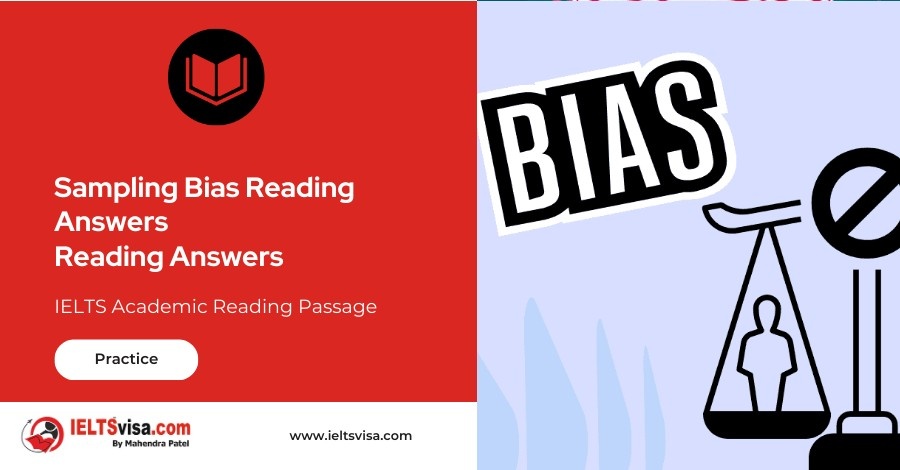Sampling Bias Reading Answers
IELTS Academic Reading Passage
Questions 14 to 18:
Write an answer in boxes from 14 to 18 by using:
- True: if the statement matches with the writer’s point of view
- False: if the opinion of the writer contradicts the statement
- Not Given: if there is no information about the statement
Question 14. Cavemen were often very good artists.
Question 15. Surveys can be done cheaply by telephone.
Question 16. Surveys can usually give reliable information.
Question 17. The elderly and disabled people are often at home during the day.
Question 18. Larger survey samples can reduce sampling bias.
Questions from 19 to 24:
Write answers using no more than two words in the answer box given from 19 to 24.
19. Self- Sampling bias
20. Opinionated respondents are over-represented
21. need to maximize number of responses
22. ensure interviewers are well-trained
23. give complete and honest answers
24. to build trust
Questions from 25 to 26:
Choose the best suitable answer from the options given below each statement. Write the answer in the box from 25 to 26.
25. The number of sampling variables
A. is usually not so large.
B. can result in important input being lost.
C. means many locations need to be used.
D. can result in lists being necessary.
26. Mathematical extrapolation
A. can yield confident results.
B. requires responses from both men and women.
C. needs exact ratios.
D. needs many respondents.

Solution For: Sampling Bias
Reading Answers
| 14 NOT GIVEN | 15 TRUE |
| 16 FALSE | 17 TRUE |
| 18 FALSE | 19 Self-selection |
| 20 Opinionated perspectives | 21 maximise (the) |
| 22 sufficiently trained | 23 introductions |
| 24 trust | 25 B |
| 26 C |
Review and Practice
- Regularly practice with IELTS reading samples and time yourself to get used to the pressure of the exam.
- Review your mistakes to understand where you went wrong and how to avoid similar errors in the future.
Our Books
Master IELTS Speaking Part 1
IELTS Writing Task 1 Book
IELTS Writing Task 2 Book
Sampling Bias Reading Answers Explanation
Comin Soon
Practice IELTS Other Modules
IELTS Listening
The IELTS Listening test assesses how well you can understand spoken English in various contexts. It lasts about 30 minutes and is divided into four sections with a total of 40 questions. The listening tasks become increasingly difficult as the test progresses.
IELTS Academic Reading
The IELTS Academic Reading section assesses your ability to understand and interpret a variety of texts in academic settings. It is designed to evaluate a range of reading skills, including skimming for gist, reading for main ideas, reading for detail, understanding inferences, and recognizing a writer's opinions and arguments.
IELTS Speaking
The IELTS Speaking test assesses your ability to communicate in English on everyday topics. It lasts 11-14 minutes and consists of three parts: introduction, cue card, and a discussion based on the cue card topic.
IELTS General Reading
IELTS General Reading tests your ability to understand and interpret various types of texts. Here are some key areas and types of content you can expect to encounter in the reading section, along with tips for effective preparation.
IELTS Academic Writing Task 1
In IELTS Academic Writing Task 1, you are presented with a visual representation of information, such as graphs, charts, tables, or diagrams, and you are required to summarize, compare, or explain the data in your own words.
IELTS General Writing Task 1
In IELTS General Writing Task 1, you are required to write a letter based on a given situation. The letter can be formal, semi-formal, or informal, depending on the prompt. Here’s a breakdown of the key components to include in your letter
IELTS Academic Writing Task 2
In IELTS Academic Writing Task 2, you are required to write an essay in response to a question or topic. Here’s a guide to help you understand the essential elements of this task
IELTS Exam Tips
To succeed in the IELTS exam, practice regularly, familiarize yourself with the test format, improve your vocabulary, develop time management skills, and take mock tests to build confidence.
Grammer for IELTS
Grammar is the foundation of effective communication in English. Understanding tense usage, subject-verb agreement, and sentence structure enhances clarity and coherence in writing and speaking.
Vocabulary for IELTS
Vocabulary plays a crucial role in the IELTS (International English Language Testing System) exam, especially in the Speaking and Writing sections. Here’s an overview of why vocabulary is important and how it impacts your performance
RECENT IELTS SAMPLES QUESTIONS AND ANSWERS
Walking with dinosaurs
Peter L. Falkingham and his colleagues at Manchester University are developing techniques that...
Money as the Unit of Amount Reading Answers
The most difficult aspect of money to understand is its function as a unit of account. In...
WEATHERING IN THE DESERT
In the deserts, as elsewhere, rocks at the earth's surface are changed by weathering, which...
Nature on Display in American Zoos
The first zoo in the United States opened in Philadelphia in 1874, followed by the Cincinnati...
Can We Prevent the Poles From Melting
Such is our dependence on fossil fuels, and such is the volume of carbon dioxide we have...
Air conditioning the earth reading answers
The circulation of air in the atmosphere is activated by convection, the transference of heat...













